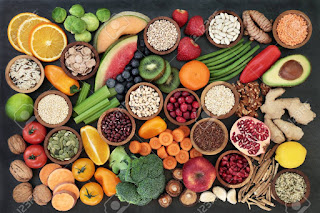- Get link
- X
- Other Apps
- Get link
- X
- Other Apps
Hey guys, I hope your family and you are safe. In this pandemic time, we all should be very careful about our health safety, because of this I am writing this post to share the 10 Healthy food tips during Self- Quarantine. Yes, it is true that by maintaining social distance, ware masks, using sanitizer we can break the chain of spreading the infection. But what we do if feel infected, or after coming from travel.
The first thing that we should do to keep ourselves isolated from our family. Follow all self-quarantine rules which are directed by the government. A proper food diet is also needed to follow for recovery soon.
10 Healthy food tips during Self- Quarantine:
When you are in self-quarantine, you should always take care of the below-mentioned points:
1. Try to eat lots of fruits and vegetables:
Fruits and vegetables are amongst the most important source of vitamins, minerals, and fiber to our body that needs good health and healthy immune function. We should try to eat at least 5 parts (equal to around 400g) of fruits and fresh vegetables all day.
As we know that the different colored vegetables and fruits give various combinations of vitamins, minerals. You should make sure to add different types to your daily meals if possible.
2.Control the portion sizes:
It can be difficult to prepare portion sizes right, especially when we are cooking at home. But it is also very important to know what the right portion looks like can help us manage energy balance, and avoid under-or overeating.
Explore guidance through your national food-based dietary guidelines.
3. Try to Stay hydrated:
Good hydration is essential for optimal health. Whenever available and safe for drinking, tap water is the most salubrious and cheapest drink. It is also the largest sustainable, as it generates no waste, in comparison to bottled water. Drinking water instead of sugar-sweetened drinks is a simple way to manage our intake of sugar and excess calories. If you want to enhance its taste then you can add fresh or frozen fruits like berries, mint, lavender, or slices of citrus fruits into it.
Try to avoid drinking large quantities of strong coffee, strong tea, and mainly caffeinated soft drinks and energy drinks. All these can lead to dehydration and may gives a negative impact on your sleeping patterns.
4.Limit your salt intake:
The availability of fresh foods may decrease and it may therefore become necessary to rely more on canned, frozen, or processed foods. Many of those foods contain high levels of salt. WHO recommends consuming less than 5 g of salt per day. To achieve this, prioritize foods with reduced or no added salt. You may also consider rinsing canned foods such as vegetables and beans, to remove some of the excess sodium. Be aware that pickled foods often contain high levels of sodium too. In many countries, 50–75% of the salt intake comes from the foods we eat, rather than what we add to us. Given that you might be consuming enough salt already, avoid adding extra salt when cooking and to your meals at the table. Experiment with fresh or dried herbs and spices for added flavor instead.
5.Consume enough fibre:
Contributes to a healthy digestive system and gives a prolonged feeling of fullness, which helps stop overeating. To ensure an adequate fibre intake, aim to include vegetables, fruit, pulses, and wholegrain foods in all meals. Wholegrains foods include oats, brown pasta and rice, quinoa, and whole-wheat bread and wraps, rather than refined grain foods such as white pasta and rice, and white bread.
6.Enjoy family meals :
The social distancing associated with the COVID-19 outbreak has meant that many families are spending more time at home, which provides new opportunit
ies to share meals. Family meals are an important opportunity for parents to be role standards for healthy eating, and for strengthening family relationships.
Increased time at home during this period may also present new opportunities to involve children in cooking healthy foods, which can help them acquire important life skills that they can carry into adulthood. Letting children choose what vegetables to add to your meal may encourage them to eat them at the table. When involving children in cooking, it is important to keep meals simple and to teach children about proper food safety (including handwashing, cleaning surfaces, and avoiding consumption of certain raw ingredients).
7.Avoid alcohol or at least reduce your alcohol consumption:
Alcohol is not only a mind-altering and dependence-producing substance, harmful at any level consumed, but it also weakens the immune system. Thus, alcohol use and especially heavy use undermines your body’s ability to cope with infectious diseases, including COVID-19.
Alcohol also makes certain medications less effective, while increasing the potency and toxicity of others. Do not consume alcohol in combination with pain medication, as alcohol will interfere with your liver functions and might cause serious problems, including liver failure.
Under no circumstances should you consume any type of alcoholic products as a preventive or treatment measure against COVID-19.
Alcohol is not a necessary part of your diet and not part of a healthy lifestyle and should therefore not be on your shopping list.
8.Get active:
Limit screen time each day and be sure to get up and get active. Refer to our recent self-care tips or list of ways to keep kids engaged for ideas.
Your habits have an impact on those around you. Parents who set the example by eating healthy and exercising may encourage children to do the same. Enjoy meals, snacks, and activities together!
9:Eat dried and canned pulses:
Beans, chickpeas, lentils, and other pulses are great sources of vegetable protein, fibre, vitamins, and minerals. These are also rather versatile and can be used for stews, soups, spreads, and salads.
10. QUICK AND HEALTHY SNACK IDEAS:
- Cucumber and tomato salad drizzled with olive oil and feta cheese
- ½ cup frozen grapes
- Yogurt with ½ cup of Cheerios
- Frozen yogurt-covered blueberries
- Celery, apple slices, or banana with peanut butter
- Carrots or red pepper strips with hummus or tzatziki dip
- Strawberries and yogurt dip
- Sea salt and pepper kale chips
- Clementine and almonds
- Rice cake with peanut butter and banana
Comments





Thanks for sharing the very useful health tips.
ReplyDelete